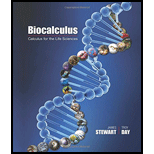
Biocalculus
15th Edition
ISBN: 9781133109631
Author: Stewart, JAMES, Day, Troy
Publisher: Cengage Learning,
expand_more
expand_more
format_list_bulleted
Concept explainers
Question
Chapter 10.3, Problem 3E
(a)
To determine
To Find: The homogeneous system of linear differential equations obtained from the change of variables.
(b)
To determine
To Find: The general solution of the system o part (a).
(c)
To determine
To Find: The solution of the initial value problem, if the initial conditions are y1(0)=1 and y2(0)=0 .
(d)
To determine
To Find: The function that represents the fraction of cells that are irreversibly resistant as a function of time.
(e)
To determine
To Find: The time taken for 50% of the cells to be irreversibly resistant.
Expert Solution & Answer
Want to see the full answer?
Check out a sample textbook solution
Students have asked these similar questions
4. Suppose that the population of a certain collection of rare Brazilian ants is given by
P(t)=(t+100) In(t+2),
Where t represents the time in days. Find and interpret the rates of change of the population on the third day
and on the tenth day.
Find all values of x for f (x)=(x²-4) 4 where the tangent line is horizontal.
5. Find the slope of the tangent line to the graph of f(x)=-√8x+1 at x=1. Write the equation of the tangent
line.
3. Find the derivative of each function. Label with appropriate derivative notation showing both dependent and
independent variables.
f(t)=4t(2t⭑+4)³
a. f(t)=4t (2t+4)³ (Answer must be factored.)
b.
y=
3
1
(2x³-4)
6
Chapter 10 Solutions
Biocalculus
Ch. 10.1 - Prob. 12ECh. 10.2 - Prob. 5ECh. 10.2 - Prob. 38ECh. 10.2 - Prob. 39ECh. 10.3 - Prob. 3ECh. 10.3 - Prob. 5ECh. 10.3 - Prob. 9ECh. 10.4 - Prob. 1ECh. 10.4 - Prob. 12ECh. 10.4 - Prob. 15E
Ch. 10.4 - Prob. 26ECh. 10.4 - Prob. 27ECh. 10.4 - Prob. 28ECh. 10.4 - Prob. 29ECh. 10.4 - Prob. 30ECh. 10.4 - Prob. 31ECh. 10.4 - Prob. 32ECh. 10.4 - Prob. 33ECh. 10.4 - Prob. 34ECh. 10.4 - Prob. 35ECh. 10 - Prob. 1CCCh. 10 - Prob. 2CCCh. 10 - Prob. 3CCCh. 10 - Prob. 4CCCh. 10 - Prob. 3TFQCh. 10 - Prob. 1ECh. 10 - Prob. 2ECh. 10 - Prob. 3ECh. 10 - Prob. 4ECh. 10 - Prob. 5ECh. 10 - Prob. 6ECh. 10 - Prob. 7ECh. 10 - Prob. 14ECh. 10 - Prob. 15ECh. 10 - Prob. 16ECh. 10 - Prob. 17ECh. 10 - Prob. 27ECh. 10 - Prob. 28ECh. 10 - Prob. 29E
Knowledge Booster
Learn more about
Need a deep-dive on the concept behind this application? Look no further. Learn more about this topic, calculus and related others by exploring similar questions and additional content below.Similar questions
- 4.3 The Chain Rule 1. {Algebra review} Let f(x)=2x²-5 x and g(x)=6x+2. Find f[g(−5)]. 2. {Algebra review} Write h(x)=√√8x-3 as the composite of two functions f(x) and g(x). (There may be more than one way to do this.)arrow_forward4.4 Derivatives of Exponential Functions 1. Find derivatives of the functions defined as follows. a. g(t)=-3.4e b. y=e√x c. f(x)=(4x³+2)e³* d. y=- x²arrow_forward4.5 Derivatives of Logarithmic Functions 1. Find the derivative of each function. a) y=ln (-3x) b) f(u)=nu c) 9(x)=x-1 lnxarrow_forward
- 3. If the total revenue received from the sale of x items is given by R(x)=30ln (2x+1), While the total cost to produce x items is C(x)=✗, find the following. a) The marginal revenue b) The profit function P(x) (Hint: P(x)=R(x)-C(x)} c) The marginal profit when x=20 d) Interpret the results of part c).arrow_forward2. The sales of a new personal computer (in thousands) are given by S(t)=100-90€-04: Where t represents time in years. Find and interpret the rate of change of sales at each time. a) After 1 year b) After 5 years c) What is happening to the rate of change of sales as time goes on? d) Does the rate of change of sales ever equal zero?arrow_forward2. Find the equation of the line tangent to the graph of f(x)=ln(x²+5) at the point (-1, In 6). Do not approximate numbers.arrow_forward
- please solve, thank youarrow_forwardEvaluate the definite integral using the given integration limits and the limits obtained by trigonometric substitution. 14 x² dx 249 (a) the given integration limits (b) the limits obtained by trigonometric substitutionarrow_forwardAssignment #1 Q1: Test the following series for convergence. Specify the test you use: 1 n+5 (-1)n a) Σn=o √n²+1 b) Σn=1 n√n+3 c) Σn=1 (2n+1)3 3n 1 d) Σn=1 3n-1 e) Σn=1 4+4narrow_forward
arrow_back_ios
SEE MORE QUESTIONS
arrow_forward_ios
Recommended textbooks for you
 Calculus: Early TranscendentalsCalculusISBN:9781285741550Author:James StewartPublisher:Cengage Learning
Calculus: Early TranscendentalsCalculusISBN:9781285741550Author:James StewartPublisher:Cengage Learning Thomas' Calculus (14th Edition)CalculusISBN:9780134438986Author:Joel R. Hass, Christopher E. Heil, Maurice D. WeirPublisher:PEARSON
Thomas' Calculus (14th Edition)CalculusISBN:9780134438986Author:Joel R. Hass, Christopher E. Heil, Maurice D. WeirPublisher:PEARSON Calculus: Early Transcendentals (3rd Edition)CalculusISBN:9780134763644Author:William L. Briggs, Lyle Cochran, Bernard Gillett, Eric SchulzPublisher:PEARSON
Calculus: Early Transcendentals (3rd Edition)CalculusISBN:9780134763644Author:William L. Briggs, Lyle Cochran, Bernard Gillett, Eric SchulzPublisher:PEARSON Calculus: Early TranscendentalsCalculusISBN:9781319050740Author:Jon Rogawski, Colin Adams, Robert FranzosaPublisher:W. H. Freeman
Calculus: Early TranscendentalsCalculusISBN:9781319050740Author:Jon Rogawski, Colin Adams, Robert FranzosaPublisher:W. H. Freeman
 Calculus: Early Transcendental FunctionsCalculusISBN:9781337552516Author:Ron Larson, Bruce H. EdwardsPublisher:Cengage Learning
Calculus: Early Transcendental FunctionsCalculusISBN:9781337552516Author:Ron Larson, Bruce H. EdwardsPublisher:Cengage Learning

Calculus: Early Transcendentals
Calculus
ISBN:9781285741550
Author:James Stewart
Publisher:Cengage Learning

Thomas' Calculus (14th Edition)
Calculus
ISBN:9780134438986
Author:Joel R. Hass, Christopher E. Heil, Maurice D. Weir
Publisher:PEARSON

Calculus: Early Transcendentals (3rd Edition)
Calculus
ISBN:9780134763644
Author:William L. Briggs, Lyle Cochran, Bernard Gillett, Eric Schulz
Publisher:PEARSON

Calculus: Early Transcendentals
Calculus
ISBN:9781319050740
Author:Jon Rogawski, Colin Adams, Robert Franzosa
Publisher:W. H. Freeman


Calculus: Early Transcendental Functions
Calculus
ISBN:9781337552516
Author:Ron Larson, Bruce H. Edwards
Publisher:Cengage Learning
01 - What Is A Differential Equation in Calculus? Learn to Solve Ordinary Differential Equations.; Author: Math and Science;https://www.youtube.com/watch?v=K80YEHQpx9g;License: Standard YouTube License, CC-BY
Higher Order Differential Equation with constant coefficient (GATE) (Part 1) l GATE 2018; Author: GATE Lectures by Dishank;https://www.youtube.com/watch?v=ODxP7BbqAjA;License: Standard YouTube License, CC-BY
Solution of Differential Equations and Initial Value Problems; Author: Jefril Amboy;https://www.youtube.com/watch?v=Q68sk7XS-dc;License: Standard YouTube License, CC-BY